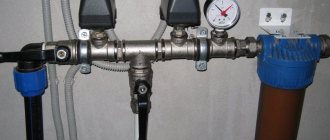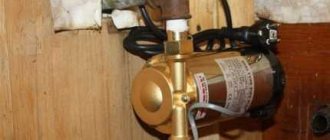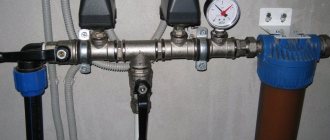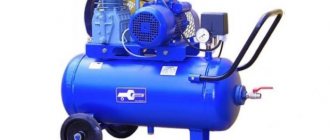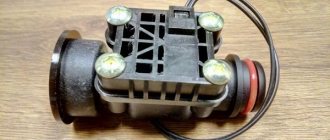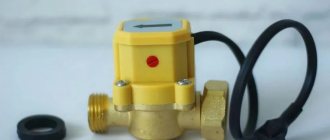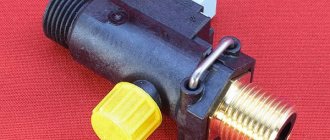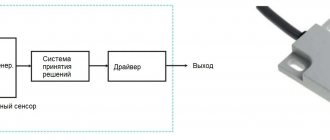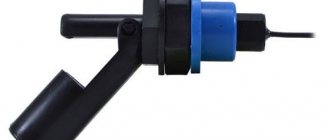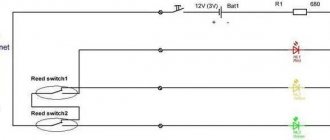Water flow sensor (relay) for the boiler and pump - types, how it works and how to do it yourself
Now we will figure out why a water flow sensor is needed (also called a “flow switch”) and look at the principle of its operation. You will also learn what types of these sensors there are and how to install it yourself.
In everyday life, sometimes an emergency switching on of a pump without water occurs, which can lead to equipment breakdown. Due to the so-called “dry running,” the engine overheats and parts are deformed. In order for the pump to function at maximum efficiency, it is important to ensure an uninterrupted water supply. To do this, you need to equip the heating and hot water supply system with a device such as a water flow sensor.
You can find out the price and buy heating equipment and related products from us. Write, call and come to one of the stores in your city. Delivery throughout the Russian Federation and CIS countries.
Design and principle of operation
A water flow sensor is a device that monitors the pressure inside the water supply system; it is connected to the pump via pipes.
Standard circuit of a water flow sensor:
- relay;
- set of plates;
- There is a wide chamber inside the device;
- a small float, which is placed inside a stationary flask;
- outlet feed channel;
- Most models are equipped with an adjustment valve installed at the outlet.
The principle of operation of the sensor: when there is no liquid flow, it automatically pauses the pumping station and does not allow dry running, and when water appears, it starts the device.
Application area
Water flow sensors are usually found in devices where it is necessary to constantly monitor the life support system and observe a certain operating mode.
Most often, water flow sensors are used in boilers operating on gas. Modern gas boilers equipped with such sensors are used for both heating and water heating.
The device, which is located on the tap water supply pipeline, when water enters, sends a signal to the boiler control board and the operation of the circulation pump stops. Then the board turns on the nozzles responsible for heating the running water, and the water in the heat exchanger begins to heat up. When the tap closes, the sensor notifies that the water supply has been stopped.
Most households are equipped with autonomous water supply systems, thanks to which you can have the most comfortable conditions.
The function of the water flow sensor is that when you turn on any of the devices connected to the water supply system, the sensor turns on the pump and water begins to flow.
When choosing a water flow sensor, be sure to consider the throughput of the devices and their size.
Types of water flow sensors
According to the type of design, relay and fitting devices are distinguished. In addition, there are varieties based on pressure levels.
A relay-type water flow sensor is used for pumps with low power. Typically these models are single-chamber. Experts note their low conductivity. Models with a vertical arrangement of plates are available, their maximum pressure is at least 5 Pa.
Protection systems are often used in the P48 series. Thanks to all these indicators, there are practically no water leaks, and such devices are also characterized by good operating stability.
The most widely used water flow sensors for pumps are in-line models. Their plates are usually placed horizontally, and some samples are equipped with two valves. Their maximum pressure is approximately 5 Pa. Protection systems are most often class P58. Conductivity is directly dependent on the size of the fitting.
Low pressure sensors are applicable for pumps with a power of no more than 4 kW. The size of the chamber affects the conductivity. Most often on the market you can find a water flow sensor for a pump with two floats. Their price is low and you can easily choose the right model.
High pressure models are usually produced with one extended fitting, the plates are mounted horizontally. Experts advise installing such samples in centrifugal pumps. Maximum pressure does not exceed 6 Pa, protection system class P70.
Also, according to the mechanism of action, it is divided into:
- a water sensor based on the operating principle of a Hall sensor: it signals not only the flow of water, but also the speed of its flow;
- a reed switch sensor operating on the principle of a magnet: inside it there is a magnetic float, which, as the water pressure increases, moves around the chamber and affects the reed switch.
Design and principle of operation of a reed switch water flow sensor
DIY installation and manufacturing
Most water flow sensors are included in the design of the devices, so they need to be installed only in the event of a breakdown and the need to replace them.
However, there are cases when the water flow sensor must be mounted separately, for example, if it is necessary to increase the water supply pressure. This is due to the fact that in the central water supply system, the pressure is low and does not reach the norm.
And in order to turn on a gas boiler in hot water supply mode, you need good pressure.
In such situations, an auxiliary circulation pump is installed, which is equipped with a water flow sensor. First the pump is installed, and then the sensor. It follows that as soon as water starts flowing, the sensor will turn on the pump and the pressure will begin to increase.
Pressure booster pump for Grundfos UPA 15-90 water supply system with built-in water flow sensor
Making a water flow sensor with your own hands is not difficult. First you need to install the camera, then you need to cut out three plates, they should be mounted horizontally, there should be no contact between them and the bulb. For a simple design, one float will be enough.
It is rational to install the fitting on two adapters; the valve must withstand a pressure of at least 5 Pa.
Manufacturers
ManufacturerCharacteristics
| Water flow sensor for pump Grundfos UPA 120 (Denmark) | Designed to provide water supply to an individual house or apartment equipped with an individual water supply system. The automatic sensor switches on when there is a steady flow of liquid in the range of 90-120 liters per hour. The main function is to protect the pump from idling. The pump starts at a water flow rate of 1.5 liters per minute. The operating voltage of the sensor is 220-240 V. Frequency of consumption current - 50-60 Hz. Maximum current consumption - 8 A. Power consumption - up to 2.2 kW. Operating temperature range - 5-60 degrees Celsius. Protection degree - IP 65. Price - about 1,800 rubles. |
| Water flow sensor GENYO - LOWARA GENYO 8A (Poland) | Used to control the pump of a household water supply system based on actual water consumption. The main feature of the sensor is monitoring the pressure in the water supply during operation. The pump starts at a water flow of 1.5 liters per minute. Operating voltage - 220-240 V. Frequency of consumption current - 50-60 Hz. Maximum current consumption - 8A. Power consumption - up to 2.4 kW. Operating temperature range - 5-60 degrees Celsius. Protection degree - IP 65. Price - about 1,800 rubles. |
| Flow sensor 1.028570 (Italy) | Designed for installation in gas double-circuit boilers of the Immergas brand. Compatible with models: Mini 24 3 E, Victrix 26, Major Eolo 24 4E | 28 4E. Designed for installation in gas boilers of the Immergaz brand, chimney and turbocharged versions. Made in a plastic case with a threaded connection. Hall sensor 1.028570 allows you to receive water at a stable temperature at the outlet of the hot water supply circuit. Price - approximately 2,400 rubles. |
Review of famous manufacturers and prices
Several models in the $30-40 price category are considered the most famous and reliable:
- Genyo Lowara Genyo 8A. Manufacturer – Poland. The main direction of the company is the production of electronic equipment for control systems. The relay is designed for use in domestic water supply systems and is characterized by high quality and long service life. By monitoring the flow pressure in the pipes, the sensor starts the pumping system at a water flow rate of 1.6 l/minute. The unit requires an electrical connection and consumes 2.4 kW/hour. Operating temperature +5..+60 C.
- Grundfos UPA 120. Manufacturer's plants are located in Romania and China. The device has small dimensions, is convenient to install and is indicated for individual water supply systems. That is, it can be used both in private buildings and apartments. The device starts up at a liquid flow rate of 1.5 l/minute, completely preventing the functionality of the system at idle. The extreme operating temperature is +60 C.
The models have been tested and adapted to domestic operating conditions. Numerous reviews characterize metering sensors as durable and practical units at an affordable price.
DIY water flow switch - Safety Portal
Taking good care of the equipment that supplies water significantly extends its service life and guarantees uninterrupted operation of the system. This requires not only timely inspection and proper care, but also equipping the pumps with a full set of protection devices. Preventing the possibility of a serious breakdown is much cheaper than repairing or buying a new unit. Do you agree?
Installing a water flow switch will protect the motor of both surface and deep-well pumping equipment. After all, most often when the motor burns out, it is easier to buy a new pump than to change it. We will tell you how this important protective device works, how to choose it and include it in an autonomous water supply.
The article provides valuable recommendations for installing devices to protect pumps from operating in “dry running” conditions. The technology of customization for individual requirements has been analyzed. For a better understanding of the considerable amount of information, photographs, diagrams, video reviews and manuals are attached.
Functional purpose of the flow switch
In household water supply systems, the action of a pumping station without water quite often occurs and threatens an accident. This problem is called “dry running”.
As a rule, the liquid cools and lubricates the elements of the system, thereby ensuring its normal operation. Even short-term dry operation leads to deformation of individual parts, overheating and failure of the equipment motor.
Negative consequences apply to both surface and deep-well pump models. Dry running occurs for various reasons:
- incorrect choice of pump capacity;
- unsuccessful installation;
- violation of the integrity of the water pipe;
- low fluid pressure and lack of control over its level;
- accumulated debris in the pumping pipe.
An automatic sensor is necessary in order to completely protect the device from the threats posed by a lack of water. It measures, controls and maintains constant water flow parameters.
Pumping equipment equipped with a sensor has many advantages. It lasts longer, breaks down less often, and uses energy more economically. There are also relay models for boilers
The main purpose of the relay is to independently turn off the pumping station when the liquid flow is insufficient and turn it on after normalization of the indicators.
Design and operating principle
The sensor has a unique device, thanks to which it performs its direct functions.
The most common modification is the paddle relay. The classic building scheme includes the following important elements:
- an inlet pipe that passes water through the device;
- valve (petal) located on the wall of the inner chamber;
- an isolated reed switch that opens and closes the power supply circuit;
- springs of a certain diameter with varying degrees of compression.
While the chamber is filled with liquid, the force of the flow begins to act on the valve, moving it around its axis.
A magnet built into the back of the petal comes close to the reed switch. As a result, the contacts close, turning on the pump.
The flow of water is understood as the speed of its physical movement sufficient to turn on the relay. Reducing the speed to zero, resulting in a complete stop, returns the switch to its original position. When setting the response threshold, this parameter is set taking into account the conditions of use of the device
When the flow of fluid stops and the pressure in the system drops below normal, the compression of the spring weakens, returning the valve to its original position. Moving away, the magnetic element ceases to operate, the contacts open and the pumping station stops.
Some modifications are equipped with a return magnet instead of springs. Judging by user reviews, they are less susceptible to minor pressure surges in the system.
Petal relays have a large number of advantages. Among them are a simple and unpretentious design, instant response, no delays between repeated responses, and the use of a precise trigger to start the equipment.
Depending on the design solution, several more types of relays are distinguished. These include rotary devices equipped with a paddle wheel rotating in a water flow. The speed of rotation of the blade in them is controlled by touch sensors. If there is liquid in the pipe, the mechanism deflects, closing the contacts.
There is also a thermal relay that operates according to thermodynamic principles. The device compares the temperature set on the sensors with the temperature of the working medium in the system.
If there is flow, a thermal change is detected, after which the electrical contacts are connected to the pump. If there is no water movement, the microswitch disconnects the contacts. Thermal relays are characterized by high sensitivity, but they are quite expensive.
Device selection criteria
When choosing equipment that controls the force of water flow, you should carefully study its technical characteristics.
Particular attention should be paid to the operating temperature and pressure range for which it is designed, the diameter of the threads and mounting holes, the protection class, and application nuances. It is also important to clarify what materials the product is made from.
Experts consider devices made of brass, stainless steel, and aluminum to be the most reliable and durable. These materials protect the structure from the critical consequences of a common phenomenon in water supply systems - water hammer.
When considering different modifications of the relay, it makes sense to purchase a version made of metal. The housing and working components of such devices are highly durable.
This fact allows the equipment to withstand serious loads for a long time that arise due to significant pressure from the liquid passing through the sensor.
The pressure value at which the relay operates must correspond to the power of the installed pump. The parameters of the water flow circulating through the pipeline depend on this characteristic.
It is advisable to choose a device with two springs that controls the operation of the pumping station according to certain lower and upper pressure marks.
The operating temperature range of the sensor directly indicates its possible area of application. For example, models with a high limit temperature are designed for hot water supply circuits and heating systems. For cold water pipelines, a range of up to 60 degrees is sufficient
Another important criterion that deserves special mention is the climatic conditions necessary for the operation of the product. This refers to the recommended air temperature and humidity level that the device needs to provide in order for it to perform at its best.
The maximum permissible load for a particular device is determined by the protection class specified in the technical specifications.
When purchasing a flow sensor, you should check the thread diameter and the dimensions of the mounting holes in the equipment: they must fit perfectly with the pipeline elements. The correctness and accuracy of further installation, as well as the efficiency of the relay after installation, depend on this.
Trusted Instruments
Among the entire range of relays, the two models that are in approximately the same price category are in greatest demand - about $30. Let's take a closer look at their characteristics.
Genyo Lowara Genyo 8A
Development of a Polish company engaged in the production of electronic equipment for control systems. Designed for use in domestic water supply systems.
Recommendations for installation and configuration
Liquid flow relays are installed for devices that require constant control and compliance with a certain operating mode. Often they are equipped with equipment at the production stage. However, there are also circumstances when a separate installation of the sensor is required.
Rules for installing relays in the system
Installing a safety device that detects the presence or absence of water flow in the system is a reasonable step in cases where it is not possible to be present while the pumping equipment is operating.
It is not required only in two cases:
- Water is pumped from a large well with unlimited resources by a low-power pump.
- It is possible to independently turn off the installation when the water level drops below the designated norm.
The device is installed on horizontal sections of the pipeline. In this case, you need to ensure that the membrane assumes a stable vertical position.
The device is mounted to the drain pipeline using a threaded coupling. Usually a special socket is provided for this.
If the pumping equipment does not have a hole for mounting the sensor, you can replace it with a brass tee. In addition to the relay, a pressure gauge is connected to it, showing the current pressure in the network
Before you start directly screwing the device, it is advisable to seal the threads well with flax or thread, sold in specialized departments.
It is better to wind it clockwise towards the end. This method of fastening increases the reliability of fixation.
In order not to damage the relay, you should screw it in very carefully, slightly tightening it with a wrench. The optimal distance between the product and the pipeline is at least 55 mm
When installing a factory sensor, you need to focus on the arrow shown on the body. The direction indicated on it must coincide with the direction of flow of the liquid passing through the device.
If contaminated water is transported through the pipeline, it is recommended to install cleaning filters, placing them near the sensor. Such a move will ensure the correct operation of the product.
At the final stage of installation work, the dry-running relay is connected to the electrical network:
- a wire core is screwed to the free ends of the two groups of contacts;
- a ground connection is attached to the sensor screw;
- the device is connected to the pump by connecting two devices with a regular wire, matching the colors of the cores.
After connecting to the network, all that remains is to check the functionality of the system. The fact that the device is ready for full operation will be indicated by an increase in pressure marks on the pressure gauge and the automatic shutdown of the pump when the limit value is exceeded.
Self-adjustment procedure
For adjustment, the sensor has special bolts. By loosening or tightening them, you can reduce or increase the compression force of the spring.
This sets the pressure level at which the device will operate.
Almost always, manufacturing companies produce equipment with adjusted settings. Despite this, sometimes additional self-adjustment is required
In most cases, setting up automatic equipment is not difficult.
It is advisable to adhere to the following algorithm:
- drain the liquid from the system until the pressure mark reaches zero;
- turn on the pumping unit and slowly let the water back in;
- record the flow pressure indicator when the pump is turned off with a sensor;
- start draining again and remember the indicators at which the pumping equipment will start working;
- open the relay and use the adjusting bolt to set the minimum level of compression of the larger spring required to activate the device and start the pump (more compression increases the degree of pressure, less - reduces it);
- in a similar way, adjust the compression force of a smaller spring mechanism, setting the limits of the maximum pressure, upon reaching which the relay measuring the water flow will turn off the pump.
Having completed all the described manipulations, you should make sure that the adjustments made are correct. To do this, the pipeline is filled with liquid and then drained, assessing the sensor’s response when the set values are reached.
If the test result is unsatisfactory, the procedure is repeated.
Having insufficient experience and qualifications, it is better to seek help in adjustment from specialists. They will analyze the specific situation, take into account the technical characteristics of the equipment and select the most correct pressure level values
To ensure that the pipeline through which the liquid passes works properly and stably, regular annual checks of the flow sensors are carried out. If necessary, the operating parameters are adjusted.
Water flow switch for pump: characteristics, principle of operation, installation
Ensuring the efficient operation of pumping units is the key to the uninterrupted functioning of the water supply and heating systems they serve.
To solve such an important task, pipelines are equipped with additional technical devices, one of which is a water flow sensor (or water flow sensor).
Its use makes it possible to control failures that may periodically occur in pipeline systems and, accordingly, minimize the risk of failure of pumping equipment.
Lobe flow sensors, non-adjustable
Purpose and benefits
When operating domestic water supply systems, there are often situations when the pump turns on when there is no liquid in the pipes.
Such situations, if they occur frequently and continue for a long time, cause overheating of the pump motor and deformation of its parts, which ultimately leads to failure of the entire device.
The water pumped by pumping equipment simultaneously performs lubricating and cooling functions, so “dry running,” as it is also called, negatively affects the technical condition of both circulation and submersible pumps.
In order to prevent the occurrence of the described situations, they use a water flow sensor for the pump, operating in automatic mode. Sensors that monitor water flow are successfully used to control the operation of pumping stations serving hot and cold water supply systems, as well as heating systems.
Sensor location diagram in the water supply system
The automatic device in question monitors the parameters of the flow of water that passes through it, and in cases where they differ from the standard ones, it automatically turns on or off the pumping equipment. Working on this principle, the sensor not only protects pumping equipment from “dry running”, but also ensures constant water flow parameters.
Among the advantages of operating pumping equipment on which a fluid flow sensor is installed are:
- reducing energy consumption and, accordingly, reducing the cost of paying for it;
- minimizing the risk of failure of pumping equipment;
- increasing the service life of pumping equipment.
Design features
The main tasks that water flow control sensors installed in domestic pipelines solve are to turn off pumping equipment at a time when there is no liquid in the system or its flow pressure exceeds the standard value, and turn it on again when the pressure drops. An effective solution to these important problems is provided by the sensor design, which consists of the following elements:
- a pipe through which water enters the sensor;
- a membrane that makes up one of the walls of the inner chamber of the sensor;
- a reed switch that provides closing and opening of the pump power supply circuit;
- two springs of different diameters (the degree of their compression regulates the pressure of the fluid flow, at which the water flow switch for the pump will operate).
Main components of an industrial flow sensor
The device of the above-described design works as follows:
- Entering the inner chamber of the sensor, the water flow puts pressure on the membrane, displacing it.
- The magnetic element fixed on the back side of the membrane, when it is displaced, approaches the reed switch, which leads to the closure of its contacts and the pump being turned on.
- If the pressure of the water flow passing through the sensor drops, the membrane returns to its original position, the magnet moves away from the switch, its contacts open, and accordingly, the pumping unit is turned off.
The operating principle of a flow sensor based on a permanent magnet and a reed switch
Sensors that monitor water flow are installed quite simply in pipeline systems for various purposes. The main thing is to choose the right device, paying attention to its operating parameters and characteristics of the pumping equipment.
Main characteristics
When choosing water flow sensors to equip a pipeline system, the following parameters must be taken into account:
- material for manufacturing the body and internal elements;
- operating pressure for which the sensor is designed;
- temperature range of the liquid to control the flow of which the device will be used;
- protection class and requirements for operating conditions;
- diameter of mounting holes and thread parameters in them.
Each of the above parameters affects the operational features of water flow sensors, so it is worth considering them in more detail.
The reliability of such a device, its ability to withstand loads arising during operation, as well as its durability depend on the material from which the sensor body and its internal parts are made. When choosing a fluid flow sensor, it is better to give preference to models for the manufacture of which various metals were used - stainless steel, brass or aluminum.
Design and principle of operation
The operating principle of the flow switch is based on the mechanical effect of the water flow in the pipeline on the sensor that controls the electronic circuit for turning on and off the electric pump. Relays have different operating principles and, depending on the design of the sensor, are divided into several types.
Petal relays
One of the most common types, the main elements are a petal sensor with a magnet located in the water flow and a reed switch placed in the device body and securely insulated.
As water flows through the pipeline, the vertically located petal sensor rotates along its axis and deviates from the vertical position, bringing the built-in magnet closer to the reed switch. Its contacts inside the cylinder are closed and the pump is connected to a source of electricity through a triac (double symmetrical thyristor).
If there is no water in the pipeline, the petal returns to its original position, moving the magnet away from the reed switch and thereby opening its contacts.
This leads to the cessation of supply voltage to the pump through the semistor, as a result of which it turns off.
Do-it-yourself water flow sensor - Metalist's Guide
Ensuring the efficient operation of pumping units is the key to the uninterrupted functioning of the water supply and heating systems they serve.
To solve such an important task, pipelines are equipped with additional technical devices, one of which is a water flow sensor (or water flow sensor).
Its use makes it possible to control failures that may periodically occur in pipeline systems and, accordingly, minimize the risk of failure of pumping equipment.
Lobe flow sensors, non-adjustable
Device connection diagram
The operating efficiency of the relay greatly depends on its correct installation. It must be remembered that the device can only be installed on those sections of the pipeline that are located horizontally. In this case, you will need to ensure that the sensor membrane is in a vertical position. The correct relay connection diagram looks like this:
During installation, the sensor must be connected to the drain part of the pipe using a threaded connection. The distance at which the relay should be located from the pipe should be more than 5.5 cm.
There is an arrow on the body of the device indicating the direction of liquid circulation. When installing the device, you need to make sure that this arrow coincides with the direction of water flow in the system. If dirty water is used for domestic purposes, then cleaning filters should be installed in front of the sensor.
DIY water flow switch
Now we will figure out why a water flow sensor is needed (also called a “flow switch”) and look at the principle of its operation. You will also learn what types of these sensors there are and how to install it yourself.
You can find out the price and buy heating equipment and related products from us. Write, call and come to one of the stores in your city. Delivery throughout the Russian Federation and CIS countries.
In everyday life, sometimes an emergency switching on of a pump without water occurs, which can lead to equipment breakdown. Due to the so-called “dry running,” the engine overheats and parts are deformed.
In order for the pump to function at maximum efficiency, it is important to ensure an uninterrupted water supply.
To do this, you need to equip the heating and hot water supply system with a device such as a water flow sensor.
Water flow switch for pump: characteristics, principle of operation, installation
Ensuring the efficient operation of pumping units is the key to the uninterrupted functioning of the water supply and heating systems they serve.
To solve such an important task, pipelines are equipped with additional technical devices, one of which is a water flow sensor (or water flow sensor).
Its use makes it possible to control failures that may periodically occur in pipeline systems and, accordingly, minimize the risk of failure of pumping equipment.
Lobe flow sensors, non-adjustable
Installation features
Paddle switches are mounted either at the pump inlet or at the valve inlet. Their task is to record the initial entry of liquid into the working chamber, and therefore contact with it must be detected first of all on the relay itself.
Pressure control units are installed only with the help of specialists, as they require adjustment. They are installed in the same way as the petals, by connecting the inlet to the pumping device. However, unlike conventional petals, pressure switches are almost always used in conjunction with pumping stations.
Thermal relays are rarely used separately, since the thing is too expensive. It will most likely be connected at the assembly stage of the pump itself. However, a good master will certainly be able to cope with the installation of this device. The complexity of the installation lies in the need to mount several sensitive thermal sensors, and then bring them together.
